
Max Cage is the heroic alter ago of the mild-mannered reviewer and commentator of comics, crime and all manner of pulp. He knows you have better things to do than read his musings but can’t imagine exactly what that could be.
Have you ever noticed that in Korean crime movies, there’s a shit ton of street fighting with blades and blunt objects, but a distinct lack of gunplay? When guns actually do come into action, it’s a shocking moment and generally game-changing. This is markedly different from their Chinese brethren, which have made a signature of depicting grand handgun battles as slow-motion martial arts ballet. This is a notable example of how very different crime fiction can become when passed through the lenses of other cultures with different attitudes towards (and presumably, access to) firearms, among other things. I find those differences fascinating and how much they also shine a light on how similar our stories all are at the center. Noir is still noir and people do bad things in any language.
Most of my experience with other cultures’ crime fiction has been through movies, probably starting with Chow Yun Fat and the films of John Woo, expanding into the wild world of Hong Kong Action Cinema. Later, I became interested in Korean crime flicks through the gateway drug that is Oldboy and Park Chan-wook‘s now-classic Vengeance trilogy.
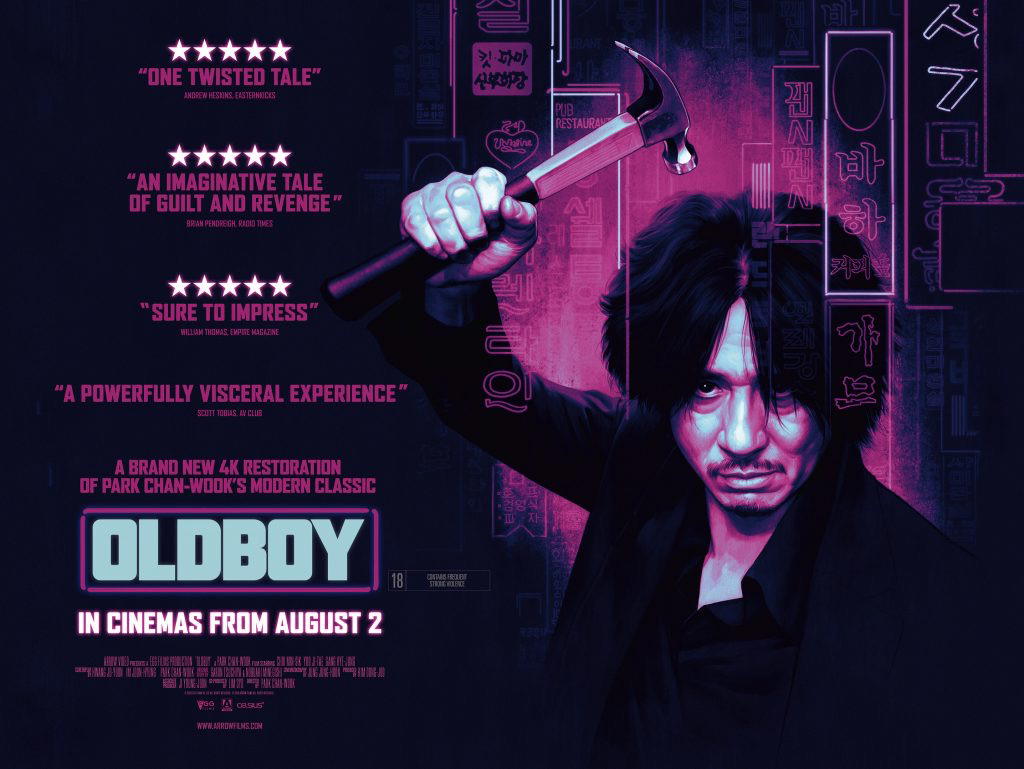
In comics, my exposure to crime fiction from other cultures probably began with following the distinctive 100 Bullets artist Eduardo Risso back to the colorful Argentine crime comics scene and its patron saint, Carlos Trillo. From there it was obvious to discover Spain’s crime fiction style with Enrique Sánchez Abulí & Jordi Bernet‘s Torpedo, and the list continues (we’ll get to more of these in future installments).
The only Indian comics of any flavor I had been aware of was Virgin Comics, a short-lived experiment in “international comics” funded by that super rich guy Sir Richard Branson. Virgin had made a bit of noise for a couple of years pre-2010, then were sold and …well, we never heard from them again. Still, with Deepak Chopra and Shekhar Kapur as creative directors, there had to be some powerful talent involved and MUMBAI CONFIDENTIAL demonstrates precisely that, coming as it does from former Virgin creators Saurav Mohapatra and Vivek Shinde.
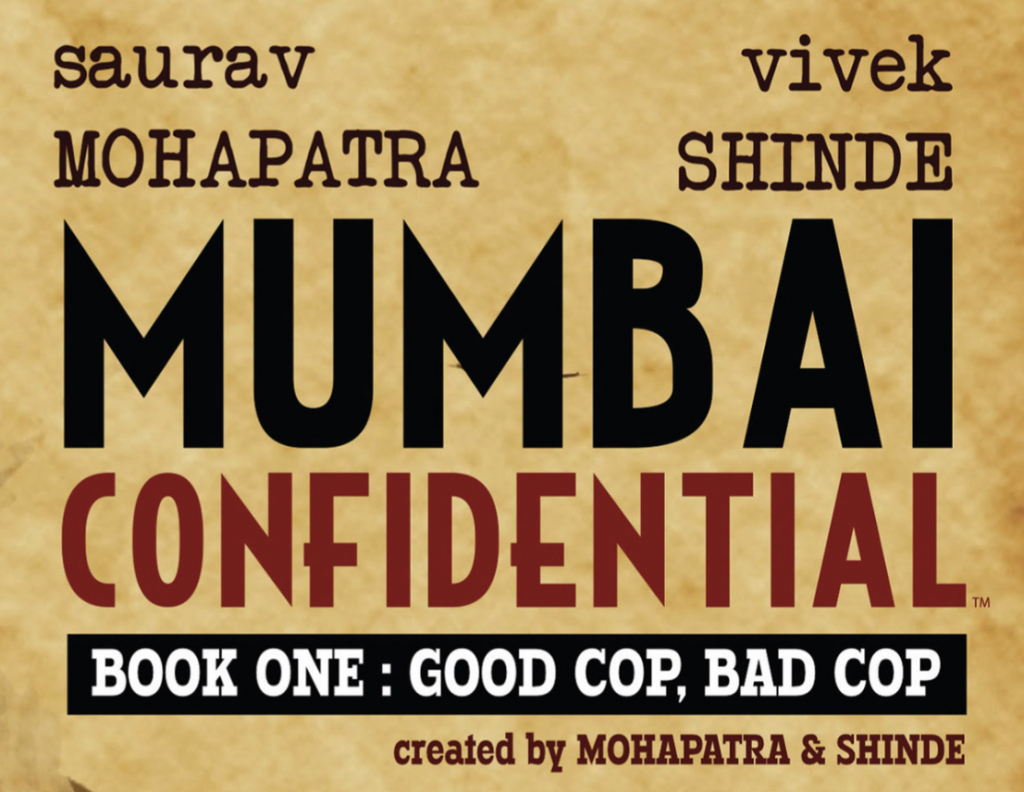
MUMBAI CONFIDENTIAL features a background situation too bizarre to be real, that somehow manages to be completely true: the Mumbai Police Encounter Squad. I had never heard of this, had you? Apparently in the 90s —yes, the 90s! — the gang-crime problem was so bad in Mumbai that a police squad was formed to basically start murdering gangsters during staged raids. The euphemism on the paperwork was that these began as “encounters” and the hit team came to be known as the Encounter Squad. This was basically Vic Mackey and his criminal Merry Men and just like in FX’s The Shield, the team became instantly corrupt and evolved into the scariest of all the gangs.
Holy smokes! That is truly bad-ass and what’s even cooler is that this Encounter Squad stuff is not even the main story! No, this story is much more personal, dealing with a former member of the Squad and his mounting losses. Much of that amazingly true stuff is background color and setup for a bleak revenge yarn.
The story begins in the rain, which is high noir style and also a feature of Mumbai. That rain, actually a monsoon described as “Heavens pissing water”, conceals violence and treachery and in the first pages we witness our hero’s presumed end. Picking up at the finale is an honored crime story tradition, and we’ll bounce around on timeline quite a lot as the tale unfolds.
In those first pages where we meet our tarnished hero Arjun Kadam, whose narration is at times aggressively tough-guy noir, but you’ll get no complaints from me! I’m a sucker for a colorful crime narrator and this one’s telling his grim tale at the end of a very long and bloody journey, which we are about to follow over the course of 150 pages.
We settle into two alternating narratives, Five Years Ago and Today. Then, Arjun Kadam had a wife and a baby on the way and while he was a hitter for the Encounter Squad, he at least felt super bad about ambushing and murdering bad guys. Not such a bad dude, right? Today, Kadam is a broken man who has lost absolutely everything, a drunk and a junkie who almost gets killed in an alleyway hit-and-run. He survives and finds new purpose in avenging the young girl who was killed by the same hit-and-run driver.
Evil acts performed in the name of good remain evil and Kadam is being cosmically punished for his misdeeds in Western-noir fashion and overlaid is this decidedly Eastern-noir quest for karmic redemption through bloody revenge.
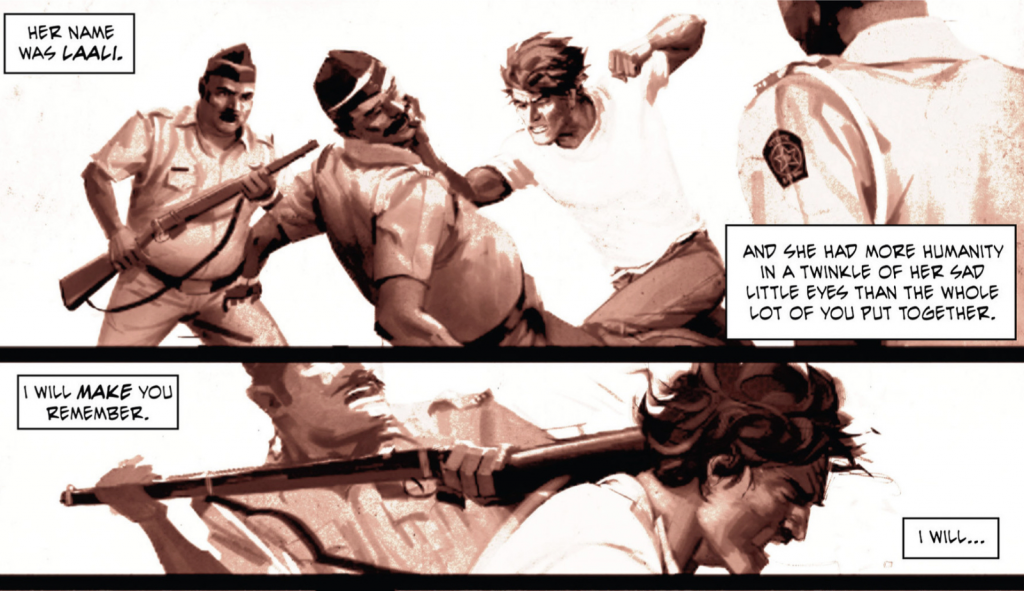
Learning how Kadam has been brought so low is a tragic thread that culminates in the present with him trying to recover some shred of his long-abandoned honor. His story is grim and relentless, especially after he comes to accept that his only chance at any kind of success is to further abandon his empathy. Yeah, that makes just as much sense as anything does in this grand noir tradition of ours. Really, that’s when Kadam becomes the most purely ‘crime’ over ‘comic’; he accepts that his revenge is an act of selfishness and abandons any notion of being a “good guy”.
In addition to the actual narrative, we also have several context-dealing short stories. These are largely just little noir bites, vignettes adding depth to some characters or fleshing out some relationships or bits of history. Several cluster at the end, moody bits of prologue standing in as epilogue. Tight pieces of further insight into India’s crime fiction culture, I enjoyed them for that as much as the added context to the main narrative.
These vignettes, ‘interludes’ as they’re labeled in the book, are done by different artists and in a completely different art styles, further serving to distinguish them as footnotes. The first, called “Remaster”, comes just after we learn some of what happened to Kadam’s family to lead to his shattered Today state; we drop into a vignette that we infer is some time after his loss and it illustrates the despair he living in, his obsession with re-watching an old videotape of his lost wife. It’s a poignant bit of punctuation that while not necessary to the story, enriches it.
The penultimate interlude “Full Moon” is another of my favorites, putting a bleak final comment on events before the book draws to a full close. It’s only connected to the main story in a tertiary way, featuring a past bad deed committed by the Bollywood star Khan, a character relatively minor to the larger narrative, showing how he comes to be under the thumb of Inspector Sunil Sawant. It’s got the first fun twist that you can see coming, and then that final, brutal twist you wish you couldn’t. The art in this one is extra cartoony and exaggerated, with nice cheesecake shots of the girl. Some visual levity to help mask the psychic bruises being inflicted.
Vivek Shinde’s art in the main story is gorgeous and moody, very watercolory-painterly in effect, with an added graininess to match the doomed tone of the story. The rain pelts down, hazing the slums into impressionistic smears; “Heavens pissing” into these hovels, indeed. Color comes into play constantly, with drab, muted tones painting the slums. Bright colors are reserved for the wealthy and influential of Mumbai, the brightest still for the obscenely rich Bollywood stars. Qureshi, the gangster whose fate is interwoven with Kadam’s, is a looming figure in dark robes, splashes of red shrouding him like vestments and denoting his special place on this influence scale.
An exception is the young flower-seller, the doomed girl who awakens Kadam from his self-indulgent stupor. She wears a pale green shift and I am reminded that green is the color of ghosts in the language of film. Hm, you don’t say.
Kadam himself is almost completely colorless, except for his tee shirt, pale yellow in the final arc in Today’s (tonight’s) timeline. Possibly it’s meant to help you keep track of Kadam through the time jumps, just as a beautiful satin scorpion jacket records every physical insult received by Ryan Gosling in 2011’s Drive. If that’s the intent, I’m not sure it completely works, since there’s two different points in time when Kadam’s pale yellow tee is notably bloodstained.
The moodiness of the art allows the out-of-order narrative to unfold and fill itself in without the reader having to cling too much on precisely ‘when’ we are. Something comics do particularly well is tell story out of sequence, possibly because comics readers’ comfort with flexible continuity.
Our central characters are all given unique appearances that marry perfectly to how they’re written, and are consistent and memorable. The previously mentioned and thoroughly cool gang lord Qureshi looms threateningly in all of his scenes, robed bulk and skullcap and ever-present hand cannon. Senior Inspector Sunil Sawant (holy sibilance, saab!), all rolled-back cuffs and open collar below a fearsome mustache and cruel eyes. Vishnu T. Damle, Assistant Commissioner of Police, bullet-headed, solemn frown and unreadable eyes. Broken, desperate Arjun Kadam, boy-band haircut grown shaggy, collecting beatings and bullet wounds.
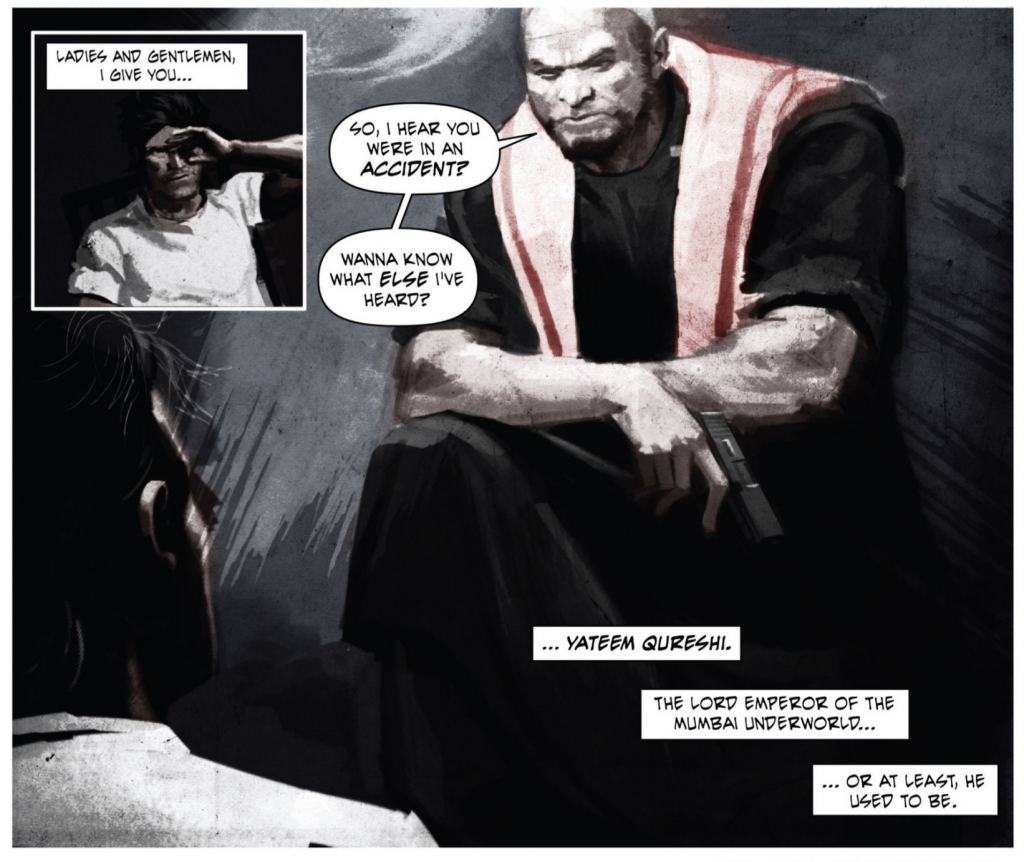
Vivek Shinde’s artwork skillfully coveys emotion and mood both in face acting and body language, though faces is definitely where his interest lies, at times to the detriment of other panels. Here or there a couple of transition panels stand out as unfinished, perhaps rushed. Never the really powerful moments or important sequences; those are carefully rendered to heighten the emotional drama of the characters in the story over any action.
The action scenes (which do feature standard levels of gunplay, by the way) are actually few in number, in keeping with noir tradition. When we do get an action sequence (do beatings count?) it’s more the impression of violence than a record of it. Violence is required for the darkness of the story, but it is not reveled in. Kadam’s swollen face is a reminder of the beatings he’s taken in his quixotic quest. Violence and cruelty is part and parcel of life in Mumbai.
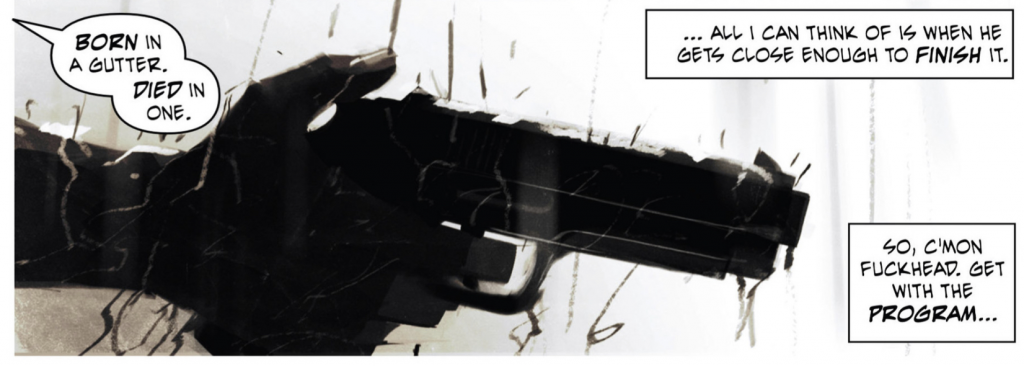
My main criticism about the artwork actually concerns Mumbai. The city’s name is in the title of the comic, so the city needs to be a living character. While we get that in spades from the narrative, the artwork isn’t quite pulling its weight here. My real impression of the infamous slums of Mumbai still come from Slumdog Millionaire, not this comic, which is a sadly missed opportunity. Most of our time is spent indoors (maybe that’s a point — Mumbai’s overpopulated?) or in nondescript slum alleys… this could be Los Angeles. In the couple of wide shots we get of the city, it’s smeared and obscured by monsoon rain or dawn’s fog. I found myself left wanting to see more of the dangerous and class-divided Mumbai of 20 million souls that I was reading about.
With a title designed to evoke LA CONFIDENTIAL, you’re going to have to really bring it, right? Like with “Once Upon a Time In X City”, certain expectations comes along with “X City Confidential”. That MUMBAI CONFIDENTIAL remains so vividly, grittily with me since my re-reads for this column, I’d say you bet. The noir tradition is well upheld in comic book form by Mohapatra and Shinde, and I thank them for introducing me to India’s corner of it. As this book is now almost ten years old, I’m looking forward to digging around to find more work from these creators! I’ll be sure to keep you posted on what I turn up.
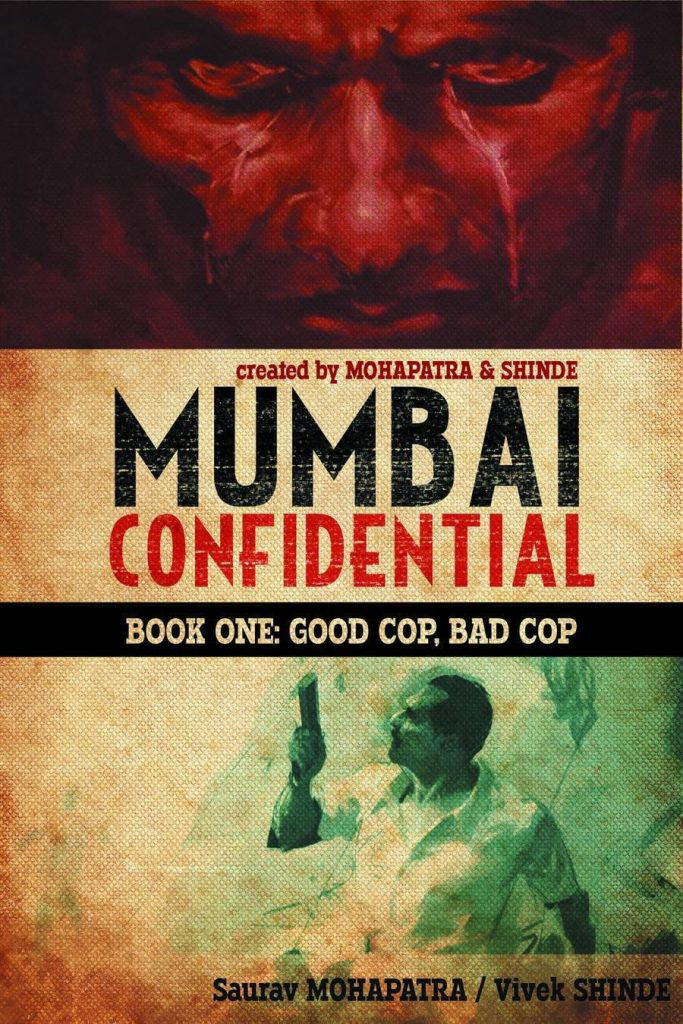
If you want to read MUMBAI CONFIDENTIAL (and yeah, you do), you’re in luck! There’s a couple of editions floating around out there and you can find a copy for great prices. As always, check in at your local funnybook emporium, but don’t be surprised if they don’t have a copy on hand or easily accessible. Dark crime fiction’s a niche interest to begin with and crime comics, especially from unknown, foreign names? Never going to set sales charts on fire or even be much remembered when shops have to deal with such a volume of content, good and bad, past and present. You might also want to try one of those discount book clearinghouse sites like hpb.com or betterworldbooks.com.
Digital readers might be out of luck right now, as I don’t see this available at the usual suspects. Which is weird, because it appears that this was originally produced as a digital-first series before seeing print as a collected edition. Maybe the rights have reverted to the creators and they have yet to cut a new deal. The website hasn’t been updated in forever, though their Twitter shows some more recent signs of life from… oh darn, almost two years ago… so your guess is as good as mine on any of this, much less the likelihood of a second volume.
The publisher on my hardcover edition is Archaia, which became an imprint of Boom! Studios some time back. Again, I am guessing the rights are no longer with them, because there is no mention of MUMBAI CONFIDENTIAL on the Boom site.
Indian noir is exactly like any noir, Indian crime is all crime. It’s reassuring somehow, seeing classic plots about desperate, doomed people reflected through the funhouse mirror of an ‘alien’ culture. It further humanizes an ethnic group that’s still struggling for acceptance in the West, which is always a good thing. I am interested to understand more about Indian crime — do even their crime movies feature dance numbers? I’m going to find out!
Until next time, to my mean-spirited collaborators I say, Namaste!
Max Cage, 2022
Comics’ll Break Your Heart, for Shotgun Honey

When Kadam is the victim of a hit-and-run that also claims the life of a street urchin, he goes into coma for a month. Upon awakening, he finds a new sense of purpose and pursues the investigation, taking him on a journey through the deep, dark heart of Mumbai

Max Cage is the heroic alter ago of the mild-mannered reviewer and commentator of comics, crime and all manner of pulp. He knows you have better things to do than read his musings but can’t imagine exactly what that could be.